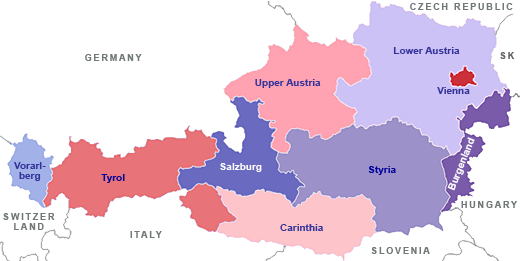Geography and population

Austria covers an area of 83,878 square kilometres with a population of 9,159,993 residents (as of 1 January 2024; preliminary results), including 1,801,184 foreign citizens (19.6 % of total population). In 2023, an average of 2,4 million people with migration background lived in Austria, that is 26,7% of the entire population.
Austria is bordered by Switzerland, Liechtenstein, Germany, the Czech Republic, Slovakia, Hungary, Slovenia and Italy.
Austria is a federal state comprised of nine provinces; each province has its own capital:
Province | Population | Provincial Capital | Population |
Burgenland | 301,966 | Eisenstadt | 16,016 |
Carinthia | 566,835 | Klagenfurt | 104,862 |
Lower Austria | 1,723,981 | St. Pölten | 58,846 |
Upper Austria | 1,530,571 | Linz | 212,001 |
Salzburg | 571,528 | Salzburg | 157,400 |
Styria | 1,269,945 | Graz | 302,660 |
Tyrol | 776,082 | Innsbruck | 132,174 |
Vorarlberg | 409,951 | Bregenz | 29,630 |
Vienna | 2,006,134 | - | - |
(S: Statistik Austria, 1.1.2024, preliminary results)
Economy
In 2023 the GDP rose by 6.7 % in real terms, according to preliminary calculations. The GDP at current prices was about € 477.2 bn in 2023, equalling a value of € 49,300 per inhabitant. (source: Statistik Austria).
The Austrian economic structure is mainly dominated by small and medium enterprises. The most important industrial branches are:
- Food industries
- Machine and steel industry
- Chemical and vehicle industry
- Electric and electronic industry
- Wood and paper industry
Climate
Austria has a typical central European transitional climate, i.e. warm summers, cold winters and adequate precipitation.
Additionally, there are two distinct climatic regions in Austria:
- The east shows a Pannonian climate (warm to hot summers, relatively low precipitation and cold winters).
- The central Alpine region has the characteristic features of the Alpine climate (more precipitation in summer compared to the east and long winters with heavy snowfall).







 Top
Top

